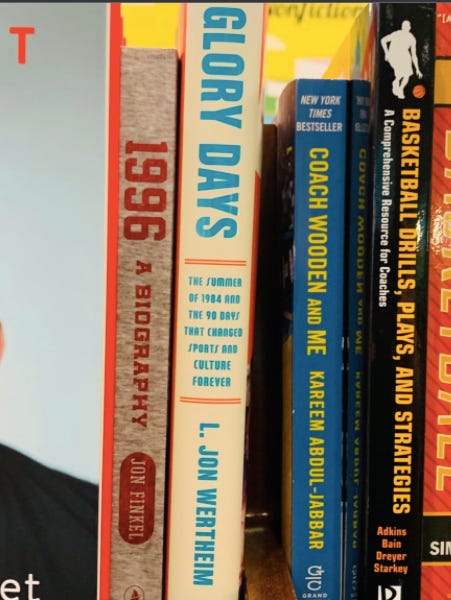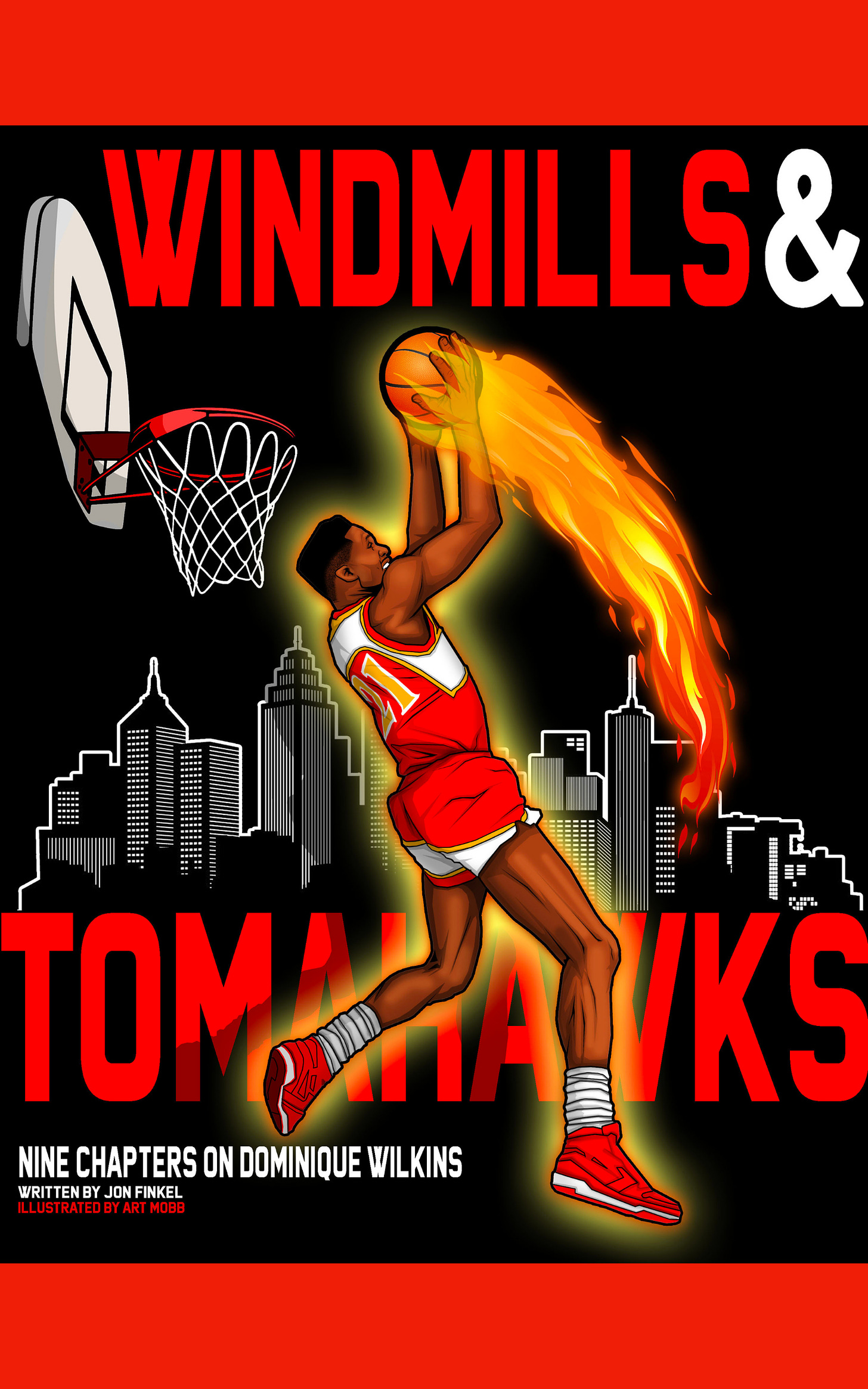💪Books & Biceps - Issue 195
Your 5-Minute Friday Flex with today's special guest author Jon Wertheim
Books & Biceps is the only weekly e-mail that combines reading recommendations, bestselling author interviews, legit workouts and more.
Join thousands of us by clicking ‘subscribe’ below:
BOOKS
Glory Days: The Summer of 1984 and the 90 Days that Changed Sports and Culture Forever by Jon Wertheim
This week’s Behind-the-Book Q&A is one of the coolest we’ve done for several reasons. The first of which is that it features Jon Wertheim, one of the best, most respected sports writers around and an author I personally admire. Wertheim is an executive editor at Sports Illustrated, was featured in a bunch of Best American Sports Writing volumes and he’s written a bunch of great books, the most recent of which is Glory Days.
This brings us to the second reason why this interview is so cool. Jon and I, completely unbeknownst to each other, came up with ideas to write books about iconic sports years that shaped not only our childhoods, but the greater sports landscape at large. Wertheim focused on 1984 and as you all know I wrote mine on 1996.
The two books go absolutely perfectly together. In ‘84 Wertheim covers the rise of Jordan and Olympic hoops and Mike Tyson and ESPN and so many other icons and events that became the backbone of our sports universe. Then in ‘96 we get to see Jordan at his peak, and Tyson’s comeback and ESPN’s The Big Show and a new cast of characters. I loved reading Glory Days. It’s an excellent book and if you grew up as an 80s or 90s sports fan, it really is a must read. It’ll take you right back in time.
This week I was in a Barnes & Noble and funny enough, our books were displayed side-by-side. It was an honor to be paired with Wertheim and it made me smile. It also made me want to reach out to see if he’d do a Q&A for us about his process behind writing the book…and he thankfully agreed. This is an awesome interview (do not skip the bonus question!!!).
Please enjoy this week’s Behind-the-Book Interview with Jon Wertheim:
BEHIND THE BOOK Q&A with Jon Wertheim
ONE
FINKEL: As I moved into my late 30s I slowly became obsessed with the sheer amount of insane sports icons, teams and events that took place my senior year in high school, which was 1996. It was an incredibly impressionable time for a generation of 90s kids and around five years ago I knew I had to write a book about that year. What’s awesome about Glory Days is that you clearly had a similar obsession with 1984. You were 13 years old at the time, a quintessential 80s kid. When did the idea first hit you to write a book chronicling that incredible summer of ’84? And aside from the mega stars, who were your personal favorite athletes from that time period you’d want people to appreciate now?
WERTHEIM: I wrote a piece for Sports Illustrated about Michael Jordan coming to my town in the spring/summer of 1984….and the happy absurdity of the Olympic Basketball trials being held —with remarkably little fanfare – a bike ride from my home. Someone lodged a suggestion that I try and dilate this mag story into a book. The great Jack McCallum had just written “Dream Team”—setting an impossibly high bar for an Olympic hoops book. But then I fired up the godsend that is newspapers.com, and went through the SI archives and realized the heavy concentration of these extraordinary sports events that occurred that summer. I grabbed onto the idea that Michael Jordan’s transformation that summer mirrored the transformation of sports…and I was off.
In the summer of 1984, sports were still so regional and balkanized. If you’re a kid in Indiana, you really have to try to familiarize yourself with, say, the Portland Trail Blazers. So my favorite athletes came in two varieties. Hyper-local (Steve Alford, Ryne Sandberg, Clark Kellogg) or these almost mystical figures you like the same way you like a cult band. You may not have seen them live; you had to work to find them—but your pursuit paid off. Yannick Noah, Rickey Henderson, Benny Anders (whom I’d later write about for SI) are three that spring to mind.
TWO
One of the things I discovered when writing ’96 was just how much the hierarchy of sports has changed in 25 years. Baseball & boxing & tennis were massive in the 80s and 90s. Now, not so much… In ’84, you covered a crop of mega stars that people might have a hard time understanding just how big they were at the time. The rise of Mike Tyson. The peak media obsession with John McEnroe. What is the biggest difference between how the media covered (and created) stars in the early 80s versus 2021?
The short answer is social media. The athlete didn’t have this in-house PR organ—and they were not as afraid of the blowback that comes from being controversial…..So a) they were less guarded and media-skeptical b) the conventional media was able to take a more active role in the star making. To whom do journalists gravitate? The stars who make their job easier, providing maximum color and content and quotes….and familiarity. You mention Tyson and McEnroe. I think it’s not a coincidence that both were based in New York, easily accessible (not just geographically but culturally) from the media center of Manhattan. That they could back up their menace/antics with winning, only added to the appeal.
THREE
What was the number one fact or piece of information you discovered in your research for the book that made you completely change the way you thought about one of the athletes you followed as a kid? Good, bad, whatever. Like a moment where you said, “wow, I never knew that!”
Oh, man. I guess big picture….A) the rise of cable and the role it would play for decades. B) the vision of David Stern. He got the job in 1984, oversaw the Jordan draft and the Celtic/Lakers finals. He benefitted from good fortune, for sure. But in 1984, he was already saying things like “we need to stress international growth” and “corporate America should help us create stars.” …more prosaically? Who knew that Bob Kraft never would have owned the Patriots but for the disastrous Michael Jackson Victory tour?
BONUS:
I love the nods to pop culture in the book, especially the chapter on the Karate Kid. What was the in-theater experience like when LaRusso crane-kicked Johnny in the final fight? Bedlam? Standing ovation?
By total coincidence…I saw Karate Kid in the College Mall Cinema in Bloomington and only caught parts of it because Patrick Ewing was seated a few rows ahead of me, obstructing my view. True Story!
BICEPS
I’d like to introduce you to a new shoulder burning workout that anyone can do at any level of training. All you need is a barbell and a squat rack or power rack to place the bar at shoulder height.
The workout involves one exercise: the standing shoulder press.
It’s called THE SHOULDER LADDER:
After a solid warm-up, start with just the bar as your weight and lift it ten times. THEN:
Add 5 pounds to each side and lift 10 times.
30 seconds rest.
Add 5 pounds to each side and lift 10 times.
30 seconds rest
repeat this until you hit a weight that you can barely get ten times (most likely 8 or even 7)…
Then go back down the ladder, removing 5 pounds from each side and resting 30 seconds until you get back to just the bar… GOOD LUCK, BOULDER SHOULDERS!
ONE FAST FAVOR👇
If you love Books & Biceps and read it most weeks, would you do me a favor and share this with someone who you know would love it (everyone):
Or send them right to the subscribe page with this button (or if you haven’t subscribed yet, you can do that too!:
Thank you so much!
FOLLOW ME ON Twitter here.
🏀PRE-ORDER “WINDMILLS & TOMAHAWKS: Nine Chapters on Dominique Wilkins” TODAY
It’s a #1 NEW RELEASE on Amazon right now!
SEND ME A SCREEN SHOT OF YOUR ORDER AND I’LL SEND YOU A SWEET STICKER OF THE COVER.






